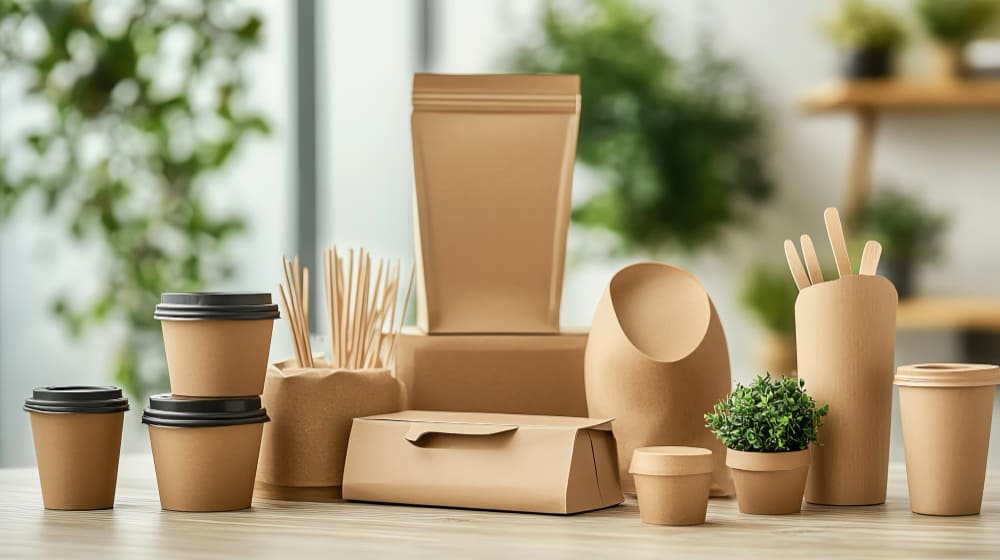As consumers become more environmentally conscious, businesses across industries are shifting towards sustainable disposable packaging. In the food and retail sectors, where disposable packaging is heavily used, the environmental impact of single-use plastics has sparked a revolution. Sustainable packaging not only benefits the planet, but it also aligns your brand with eco-friendly values that today’s consumers increasingly demand.
In this blog, we’ll explore why sustainable disposable packaging is essential, the different types available, and how your business can make a positive impact by adopting greener solutions.
Why Sustainable Packaging Matters
In the past, disposable packaging—often made from plastic, Styrofoam, and other non-biodegradable materials—was a convenient choice for businesses. However, the environmental costs are staggering:
- Plastic pollution: Over 8 million tons of plastic end up in the ocean each year, causing significant harm to marine life and ecosystems.
- Landfill overflow: Non-biodegradable packaging takes centuries to break down, contributing to growing landfill problems worldwide.
- Resource depletion: The production of conventional packaging materials requires vast amounts of natural resources, including fossil fuels.
The solution? Transitioning to sustainable packaging made from renewable, biodegradable, or recyclable materials. These eco-friendly alternatives help reduce waste, lower carbon footprints, and protect natural ecosystems.
Types of Sustainable Disposable Packaging
Sustainable disposable packaging comes in various forms, depending on the industry and product needs. Here are some of the most popular eco-friendly materials that businesses are adopting:
1. Compostable Packaging
Compostable packaging materials break down into organic matter under the right conditions, leaving behind no harmful residues. This packaging can be composted in industrial facilities or home composters, making it a highly sustainable option.
Examples:
- Bagasse (Sugarcane fiber): A byproduct of the sugarcane industry, bagasse is used to create sturdy, compostable containers for food service.
- PLA (Polylactic Acid): Made from fermented plant starch (usually corn), PLA is commonly used for clear cups, lids, and utensils. PLA is compostable in commercial composting facilities.
- Palm leaf plates: These plates are crafted from fallen palm leaves, offering a fully natural, compostable alternative to plastic or paper plates.
Pro Tip: Encourage customers to compost at home or use composting services by including labels or instructions on your compostable packaging.
2. Biodegradable Packaging
Biodegradable materials decompose naturally over time, thanks to microorganisms that break them down into harmless components. While the process is slower than composting, biodegradable packaging helps reduce the burden on landfills.
Examples:
- Biodegradable plastics: Made from renewable sources like corn starch or potato starch, these plastics break down much faster than traditional plastics.
- Paper-based packaging: Uncoated paper or cardboard packaging is biodegradable and is commonly used for items like sandwich wraps, takeout boxes, and drink sleeves.
Pro Tip: Make sure to clearly distinguish between biodegradable and compostable on your packaging to avoid consumer confusion, as biodegradable items may not always compost.
3. Recyclable Packaging
Recyclable materials can be processed and reused to create new products, preventing them from ending up in landfills. This approach is especially effective when paired with consumer education on recycling habits.
Examples:
- Paperboard and cardboard: Widely recyclable and commonly used for food containers, pizza boxes, and shipping boxes.
- Glass and aluminum: Both glass and aluminum are endlessly recyclable without losing quality, making them perfect for reusable jars, cans, or bottles.
Pro Tip: Include clear recycling instructions or symbols on your packaging to encourage proper disposal.
4. Plant-Based Packaging
Plant-based materials are derived from renewable resources, making them a greener alternative to traditional plastics that rely on fossil fuels. Many of these materials are also compostable or biodegradable, adding to their sustainability.
Examples:
- Cornstarch packaging: Made from fermented corn, this type of packaging can be used for containers, bags, and utensils.
- Mushroom packaging: An innovative material made from mushroom roots (mycelium) and agricultural waste, mushroom packaging is fully biodegradable and compostable.
Pro Tip: Highlight your use of plant-based packaging on your website and social media to show your commitment to sustainability.
Benefits of Sustainable Disposable Packaging
By switching to sustainable packaging, your business not only helps the environment but also enjoys several additional benefits:
1. Reduced Carbon Footprint
Sustainable packaging materials often have a lower carbon footprint than traditional plastics. Renewable materials, like paper or plant-based plastics, require fewer resources to produce and release fewer greenhouse gases during manufacturing.
2. Enhanced Brand Image
Consumers are increasingly eco-conscious, and they want to support businesses that share their values. By using eco-friendly packaging, you position your brand as one that cares about the environment, helping you build stronger connections with your customers.
Pro Tip: Consider adding messaging or eco-friendly labels to your packaging that explain your commitment to sustainability. Phrases like “Made from 100% Recycled Materials” or “Compostable Packaging” can make a strong statement.
3. Compliance with Environmental Regulations
As governments introduce stricter regulations around single-use plastics and non-recyclable packaging, adopting sustainable solutions can help you stay ahead of compliance requirements. Many cities and countries have already implemented bans on certain types of packaging, making sustainable alternatives a necessity.
4. Cost Savings in the Long Run
While some sustainable packaging options may have a higher upfront cost, the long-term benefits often outweigh the investment. For example, reducing packaging waste and encouraging recycling can lower disposal fees and boost customer loyalty.
How to Transition to Sustainable Packaging
Ready to make the switch to sustainable packaging? Here are a few steps to help your business transition smoothly:
1. Conduct a Packaging Audit
Evaluate your current packaging materials and identify where you can replace traditional plastics or non-recyclable items with sustainable alternatives. Look for areas where you can reduce packaging waste overall.
2. Partner with Eco-Friendly Suppliers
Work with suppliers that offer certified compostable, biodegradable, or recyclable materials. Look for certifications like FSC (Forest Stewardship Council) for paper products or BPI (Biodegradable Products Institute) for compostable packaging.
3. Educate Your Customers
Educate your customers on the importance of sustainable packaging and how they can properly dispose of it. Provide clear instructions for recycling or composting, and consider offering incentives for customers who bring back recyclable packaging or use reusable containers.
4. Measure Your Impact
Once you’ve transitioned to sustainable packaging, track the impact. Monitor waste reduction, customer feedback, and any cost savings. Celebrate your progress by sharing your sustainability efforts with your audience through social media, newsletters, or in-store signage.
Final Thoughts: Embrace Sustainability Today
In a world where environmental responsibility is increasingly important, adopting sustainable disposable packaging is not just an eco-friendly choice but a smart business decision. By reducing waste, cutting carbon emissions, and connecting with eco-conscious consumers, your business can make a positive impact on the planet—and inspire others to do the same.
Whether you opt for compostable, biodegradable, recyclable, or plant-based materials, sustainable packaging can help reduce your environmental footprint and position your brand as a leader in the movement toward a greener future.






